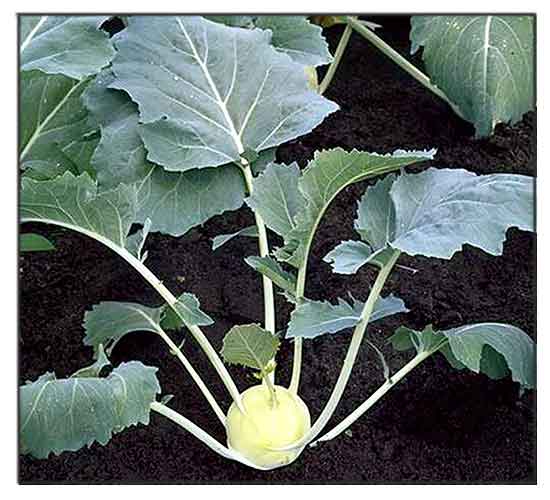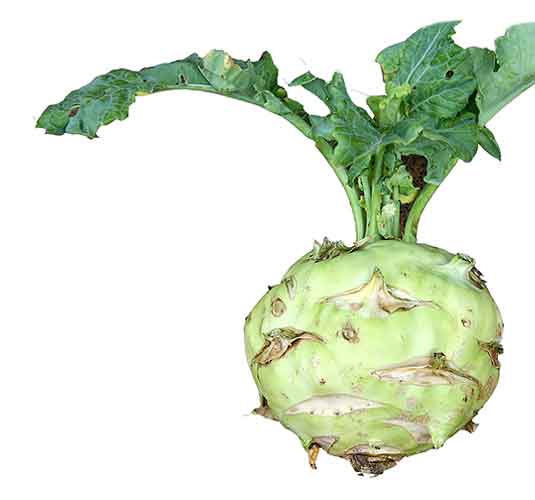 Gen info Gen info
- Brassica oleraceae has been cultivated for at least 2000 years, possibly much longer. Although considerably different in general appearance, kohlrabi, cabbage, kale, cauliiflower, broccoli and Brussels sprouts are all cultivars of Brassica oleracea. (1)
- The origin of the vegetable is uncertain. A vegetable of same description was mentioned by the Roman botanist Pliny in the 1st century A.D.
- Kohlrabi varieties are distinguished by color. Popular varieties are the Grand Duke, Kolibri F1, Purple Danube, Purple Vienna, and White Vienna. (13)
- Etymology: Kohlrabi derives from the German Kohl (cabbage) plus Rübe~Rabi (Swiss German variant) "turnip", alluding to the swollen stem that resembles it. The Group name Gongylodes derives from Greek gongylos meaning "roundish".
Botany
• Brassica oleracea var. gongylodes is a biennial growing up to 0.5 meters, Stem base is highly shortened turnip-like swollen, globe-shaped and fleshy at the base, white, purple or green with a creamy white interior, 5 to 12 cm wide, which rests on the surface of the ground. Basal and lower cauline leaves are green, numerous, not overlapping into a head. Leaves are waxy lobed or wavy, long-petioled, emerging from the swollen stems. Left to mature, the plant bears yellow four-petaled flowers in small clusters. Fruits (siliques) are elongated.
• Kohlrabi has been created by artificial selection for lateral meristerm growth (a swollen, nearly spherical shape). Its origin in nature is same as that of cabbage, broccoli, cauliflower, kale, collard greens, and Brussels sprouts: all bred from, and the same species as the wild cabbage plant, Brassica oleracea. The taste and texture is similar to broccoli stem or cabbage heart, but milder and sweeter, with a higher ration of flesh to skin. The young stem can be as crispy and juicy as an apple, tho less sweet.
Distribution
- Cultivated.
 Constituents Constituents
- Study of skin and flesh of pale green and purple kohlrabis for secondary metabolites yielded 8 glucosinolates, 12 anthocyanins, 2 carotenoids, and 7 phenylpropanoids. Glucosinolates varies among different parts and types of kohlrabi. Glucoerucin contents were 4-fold higher in the flesh of purple kohlrabi than in the skin. Among anthocyanins, cyanidin 3-(feruloyl)(sinapoyl) diglucoside-5-glucoside levels were the highest. Carotenoids were much higher in the skins than the flesh. Phenylpropanoids were higher in purple than pale green kohlrabis. Cinnamic acid was 12.7 higher in in the flesh of purple kohlrabi. (3)
- Leaves yielded chlorogenic acid, catechol, epi epigallocatechin and epicatechin3-O-gallate. Peel and flesh yielded isorhamnetic-3-O-glucoside was detected in peel and flesh. Gallic acid was only found in the flesh. Hemicellulose. chlorophylls, proteins, Na, P, and microelements amounts were significantly elevated in leaves.
Sucrose was the main sugar in stem tissues. Major fatty acids were linoleic, palmitic and oleic acids. (see study below) (6)
- Study of seeds for volatile oil by GC-MS revealed main constituents of 4-methylthiobutyl isothiocyanate (55.6%), 3-butenyl isothiocyanate (27.6%). allylisothiocyanate (5.4%), 5-methylthiiopentanitrile (3.4%), 3-mediylthiopropylisothiocyanate (2.6%) and 2-phenylethyl isothiocyanate (2.4%).
(7)
- Phytochemical screening of various extracts of stem tubers yielded alkaloids, flavonoids, resins, saponins, and tannins.
(see study below) (9)
- Study of sliced red kohlrabi tubers using methanol extract and fractions isolated 11 compounds, of which compound 1 was a new glycosylated indole alkaloid derivative, 1-methoxyindole 3-carboxylic acid 6-O-ß-D-glucopyranoside, along with known compounds, namely: β-sitosterol glucoside (4), 5-hydroxy-methyl-2-furaldehyde (5), methyl-1-thio-β-D-glucopyranosyl disulfide (6), 5-hydroxy-2-pyridinemethanol (7), (3S,4R)-2-deoxyribonolactone (8), n-butyl-β-D-fructopyranoside (9), uridine (10) and three fructose derivatives, D-tagatose (11), β-D-fructofuranose (12) and β-D-fructopyranose (13). (15)
- Nutritional value of raw Kohlrabi per 100 g (3.5oz): Energy: 113 kJ (27 cal); Carbohydrates 6.2 g: sugars 2.6 g, dietary fiber 3.6 g; Fat 0.1g; Vitamins: Thiamine (B1) 0.05 mg, Riboflavin (B2) 0.02 mg, Niacin (B3) 0.4 mg, Pantothenic acid (B5) 0.165 mg, Pyridoxine (B6) 0.15 mg,Folate (B9) 16 µg, Vitamin C 62 mg, Vitamin E 0.48 mg; Minerals: Calcium 24 mg, iron 0.4 mg, Magnesium 19 mg, Manganese 0.139 mg, Phosphorus 46 mg, Potassium 350 mg, Sodium 20 mg. (USDA Database) (18)
Properties
-
Studies have suggested antidiabetic, anti-inflammatory, antioxidant, anticancer, anti-apoptotic, analgesic, antibacterial, antilipidemic, antifungal properties.
Parts used
Leaves, seeds, peels, flesh.
 Uses Uses
Edibility
- All parts of kohlrabi are edible: the bulbous stem is most frequently used, typically raw in salad or slaws.
-
Stems consumed as vegetable; raw, cooked or fried.
- It is an important part of Kashmiri cuisine, called Monji. It is prepared with its leaves, served with light soup, and eaten with rice. (18)
- It is a common ingredient in Vietnamese cuisine, found in the dish nem ran, stir fry and canh. (18)
Folkloric
- No folkloric medicinal use reported in the Philippines.
Others
- Fodder: Used as livestock feed. Some varieties are grown as feed for cattle.
Studies
• Compositional Analysis / Kohlrabi vs Radish: The major deterrent to radish consumption is its bitter and pungent taste attributed to glycosinolates. tCompositional study evaluated kohlrabi—similar in texture and taste—as a substitute to radish. Kohlrabi contained less reducing sugars, cellulose, and pectin. Total amino acid content was 2.7-fold higher,, especially hydrophilic amino acids like aspartate, glutamate, and arginine, which might explain its comparative palatability. Glucosinolate content in radish is inner and outer section is 12 to 28 fold higher, respectively,, and a sensory test rated kohlrabi lest bitter and pungent. Kohlrabi also contained more glucoraphanin, an anticancer compound. Kohlrabi has a harder texture, and although sweeter, it contains less reducing sugars and the sweetness likely due to higher content of hydrophilic amino acids. Overall a good alternative vegetable to radish. (2)
• Anti-Diabetic / Anti-Inflammatory / Antioxidant / Green vs Red: Study evaluated the anti-diabetic, anti-inflammatory, and antioxidant potential of green (GK) and red (RC) kohlrabi cultivars. RC showed twice more TPC (total phenolic content)x and more significant antioxidant effects in DPPH, ABTS, and ONOO scavenging assays. The methanol extracts of GK and RK inhibited LPS-induced NO production in a dose dependent manner, with suppression of iNOS and COX-2 protein production. In antidiabetic and anti-inflammatory testing by protein tyrosine phosphatase (PTP1B) and rat lens aldose reductase inhibitory assays and LPS-induced NO inhibitory assays, the RK showed significantly stronger effects than GK. (4)
• Antifungal / BGAP / Seeds : Study purified an 8.5-kDa antifungal peptide, BGAP, from crude extract of seeds of BOvG. The BGAP showed broad spectrum of antifungal activity with half maximal inhibitory concentration of 17.33, 12.37, 16.81, and 5.60 µg/mL against Colletotrichum higginsianum, Exserohilum turcicum, Magnaporthe oryzae and Mycosphaerella arachidicola, respectively. Flurescence staining experiments showed Colletotrichum higginsianum, Exserohilum turcicum, Magnaporthe oryzae and Mycosphaerella arachidicola, respectively. BGAP brought about an increase in cell membrane permeability, a rise in reactive oxygen species production, and a decrease in mitochondrial membrane potential, and an accumulation of chitin at the hyphal tips of Mycosphaerella arachidicola. (5)
• Antibacterial / Antioxidant / Leaves, Flesh, and Peel: Study evaluated the antioxidant and antibacterial activities of leaves, flesh, and peel extracts. Leaves showed significantly high antibacterial (MIC 0.625 mg/mL), antiradical EC50= 0.26-0.32 mg/mL), antioxidant (EC50=0.46 mg/mL) activities. (see constituents above) (6)
• Effect on Proliferation of Preadipocytes: Study evaluated the effects of Kohlrabi on proliferation and differentiation of pig preadipovytes and 3T3L1 cells. Kohlrabi decreased proliferation of pig adipocytes but had not effect on differentiation of the cells. (8)
• rGO Nanoparticles / Anticancer / Biomass: Study reports on the easy green synthesis of reduced graphene oxide (rGO) and green synthesis approach to prepare gold nanoparticles (AuNPs) The using biomass of B. oleracea var. gongylodes. Au/rGO NC was also evaluated as photosynthesizer system for the photothermal therapy (PTT) of MCF-7 breast cancer cells. Results showed the nanomaterials caused efficient destruction of cancer cell and has potential as an excellent theranostic agent in Photothermal therapy. (9)
• Antibacterial / Stem: In antibacterial screening of B. oleracea stems, the the ethanol solvent showed maximum inhibition against gram positive bacteria Staphylococcus aureus while the chloroform solvent showed maximum inhibition again Gram negative Serratia marcescens. (see constituents above) (10)
• Antimicrobial Against Fish and Human Pathogens: Study evaluated methanol and ethanol extracts of B. oleracea var. gongylodes against fish and human clinical and food borne pathogens using disc diffusion and micro-dilution broth methods. Results showed varying degrees of antimicrobial activity on 5 of 6 tested fish pathogens. Against 12 human clinical and food borne pathogens the extracts showed inhibition zones in the range of 9.27-14.53. Some extracts showed more efficacy than traditional antibiotics. Results suggest a potential source of a natural preservative for feed/food and pharmaceutical industry. (11)
• Effect on Mesenchymal Stem Cells Viability and Apoptosis: Study evaluated the effect of Kohlrabi extract on viability and apoptosis of mesenchymal stem cells. Results showed a significant difference between cell viability between extract treated group and control. Study showed positive effects on cell survival while having inhibitory effects on apoptosis. (12)
• Analgesic / Stems: Study evaluated the analgesic potential of swollen stems of B. oleracea var. gongylodes. Activity was determined by decreases by methanol extract of non-boiled and boiled stems in intra-peritoneally administered acetic acid-induced writhings in Swiss albino mice. There were no appreciable difference in pain alleviation between boiled and non-boiled extract. At doses of 50, 10, 200, and 400 mg/kbw, the ME of non-boiled stems dose-dependently and significantly reduced the number of writhings by 22.2, 40.7, 48.1, and 51.9%; while the ME of boiled stems showed reduction of 22.2, 37.0, 48.1 and 51.9%. By comparison, aspirin at doses of 200 and 400 mg/kg reduced number of writhings by 33.3 and 5`.9%. Results showed crude extract of both boiled and non-boiled stems are effective in alleviating pain. (14)
• Effect of Storage on Physicochemical Properties and Biological Activities: Kohlrabi was packed with or without polypropylene (PP) film or wrap, and stored at room temperature for 20 days Storage showed 20.9% reduction in weight in the unpacked state, and 7.1% and 3.6% in PP film and wrap packages, respectively. Sugar content increased with storage period. Total polyphenol content decreased by 5~41%. Content of five flavonoid contents decreased by abut 18% on second day of storage and decreased rapidly to 60% by 5th day. Vitamin C content decreased significantly to 39~49% from 10th day. Total glucosinolates content tended to increase. DPPH radical scavenging activity decreased from 2nd day and by 47~49% on 20th day. Anti-inflammatory effect on LPS-stimulated RAW264.7 cells was not significantly changed. Results showed physicochemical properties stored at room temperature significantly changed from 10th day when external quality changes occur. Antioxidant activity decreased due to decrease in antioxidant-related substances depending on storage period. (19)
• Silver Nanoparticles / Antibacterial / Leaves: Study reports on the eco-friendly and cost-effective green synthesis of AgNPs using aqueous leaf extract of Brassica oleracea under the influence of direct sunlight. Using disc diffusion method, the AgNPs showed promising antibacterial activity against Staphylococcus aureus (MTCC97) and Escherichia coli (MTCC111). The biosynthesized NPs have potential for use in nanomedicine and other applications. (20)
• Antihyperglycemic / Antihyperlipidemic / Antioxidant / Phenolic-Rich Extract: Study evaluated the anti-diabetic, antilipidemic, and antioxidant activity of phenolic rich extract of BOvG in Wistar rats. Results showed significant reduction of fasting blood glucose by 64% within 7 days of treatment, along with normalization of diabetic rats' lipid profile and HbA1c. BOvG also showed protection of liver-kidney functions, evidenced by significant decrease in BUN, SGOT, and SGPT. Treatment also improved antioxidant status with increase in enzymatic activities of CAT and SOD. RP-HPLC of BOvG detected chlorogenic acid, rutin, and synapic acid. Results suggest anti-diabetic, antilipidemic, and antioxidant effects in STZ-induced diabetic rats. (21)
Availability
- Cultivated.
- Seeds in the cybermarket. |

![]()






